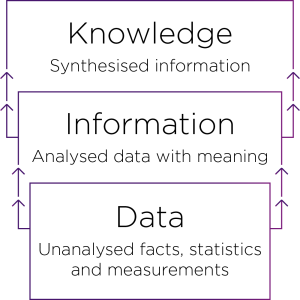1. What is information?
Information is all around us, but what does the word actually mean? Historically, there have been lots of different definitions of information. The Oxford English Dictionary defines information as ‘the imparting of knowledge in general’. However, this doesn’t actually tell us what information is.
 At the bottom of the hierarchy is data. Data are measurements, statistics and facts that when grouped together can be analysed for meaning. To learn more about data and how to use it, visit our Work with data and files module.
At the bottom of the hierarchy is data. Data are measurements, statistics and facts that when grouped together can be analysed for meaning. To learn more about data and how to use it, visit our Work with data and files module.
Information is the meaning that we get from this data. So for example, if we had a list of the number of ibises on campus from 2008 to 2018, our data would be a list of numbers. If we analyse that data, we can draw meaning out of it to create information. In this example, we could find out whether the number of ibises was the same, or if it had got larger or smaller.
Knowledge is synthesised information. This means that it is personal to us – our brains store information and use it to make judgements about the world. For example, if we know that the number of ibises has increased on campus, we might be less likely to eat our lunch outside in case an ibis steals our sandwich.
Information and artificial intelligence (AI)
AI is changing the way we create and use information. Tools like ChatGPT and Copilot use large language models, machine learning, and huge amounts of data to produce answers quickly, often faster than humans. But the way AI creates responses is very different from how humans do and it’s important to understand this so you can better judge the quality of an AI generated information. Here are some key differences:
1. Training versus experience
- Humans learn through lived experiences, emotions, and context, synthesising information from diverse sources over time.
- AI models are trained on large datasets using statistical methods. They don’t “learn” in the human sense but adjust internal parameters to better predict outputs based on input patterns.
2. Pattern recognition versus understanding
- AI excels at identifying patterns in massive datasets, even those imperceptible to humans.
- However, it lacks true understanding. It doesn’t comprehend meaning or intent but generates responses that statistically align with its training data.
3. No common sense or intuition
- Humans use intuition, emotion, and common sense to interpret ambiguous or incomplete information.
- AI lacks these faculties. It relies entirely on the data it was trained on and the structure of its algorithms, which can lead to plausible but incorrect or nonsensical outputs.
4. Contextual awareness
- Humans adapt their understanding based on evolving context, social cues, and emotional tone.
- AI can simulate contextual awareness (e.g. through prompt engineering or memory features) but it doesn’t truly “know” the context, it infers it from patterns.
5. Synthesis versus prediction
- Humans synthesise ideas, combining knowledge creatively to generate new insights.
- AI predicts the most likely next word or phrase based on training data. It doesn’t invent or reason in the human sense, it generates outputs that appear insightful.
6. Bias and limitations
- AI inherits biases from its training data and can unintentionally reinforce stereotypes or misinformation.
- Humans also have biases, but they can reflect, challenge, and change them through dialogue and experience.
When we write assignments, we use lots of different types of information to inform our work. This module will help you to identify the different types of information you might use, show you how to find information, and give you a framework for working out whether your information is good or bad.

